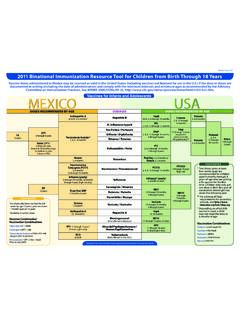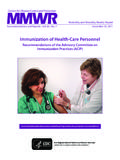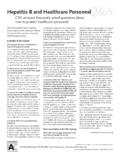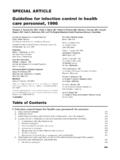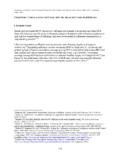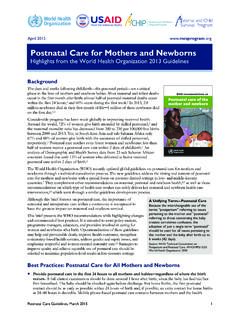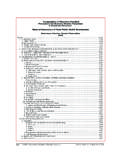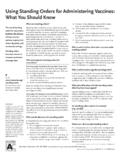Transcription of IMMUNIZATIONS TOOLKIT - sdiz.org
1 IMMUNIZATIONS TOOLKIT Do no harm .. Stick out your arm! IMMUNIZATIONS TOOLKIT Table of Contents Page I. Introduction Contributing organizations .. 1 Introduction .. 2 Acknowledgments .. 3 II. Nuts and Bolts of Influenza and Pneumonia Overview .. 5 Myths and Facts .. 11 Medicare Billing Tips .. 12 Flu Facts for Staff .. 14 LAIV Q&A for Staff .. 15 Outbreak Information .. 16 III. Loading Your Toolbox Vaccination Campaign Monthly Checklist .. 19 Employee immunization Program .. 22 Time Off Coupons .. 25 Riveting Facts .. 26 Administrator Flyer .. 28 Resident Poster .. 30 Staff Posters .. 31 Visitor Poster .. 34 Staff Newsletter .. 35 Paycheck Insert Reminders .. 36 Appointment Cards .. 38 Vaccination Sample Letters Employee .. 39 Family Member .. 40 Physician .. 41 Notice of Flu Campaign .. 42 Facility Sample Guidelines Influenza: Standing Order Guidelines .. 43 Pneumococcal Disease: Standing Orders Guidelines .. 45 Emergency Treatment Standing Orders .. 47 IV. Going to Work Sample Admission Checklist.
2 51 Buttons .. 52 Sample Tracking Form .. 53 Declination/Surveillance Forms .. 54 Family Council Overview .. 57 Family Council Flyer .. 58 Inactivated Influenza Vaccine Information Statement (VIS).. 59 Pneumococcal Polysaccharide Vaccine Information Statement (VIS).. 61 Live Attenuated Influenza Vaccine Information Statement (VIS) .. 63 Sample Vaccination 65 immunization Registries FAQ s .. 66 CAIR 69 Sample Vaccination Tally Sheet .. 70 Introduction This TOOLKIT was developed by the County of San Diego immunization Branch, health and Human Services Agency, with the assistance of the above contributing organizations. The content of this publication does not necessarily reflect the views or policies of the Department of health and Human Services nor is there mention of trade names of commercial products. Do no harm .. Stick out your arm! Contributing Organizations Oklahoma Foundation for Medical Care Dale Bratzler Centers for Medicaid and State OperationsSusan Joslin Quality Partners of Rhode Island Dave Gifford Meg Richards Teresa Leary Phyllis McBride Emily Elstad Rosa Baier Sara Freilich Marguerite McLaughlin Gail Patry Nelia Silva Odom Association of immunization Managers Claire Hannan Centers for Medicaid & Medicare Services Paul McGann Yael Harris Craig Hales American Association of Homes and Services for the Aging Ruta Kadonoff Barbara Manard Department of Labor Occupational Safety and health Administration Kay Dellinger American College of health Care Administrators Mary Tellis Nyak American health Care Association Sandra Fitzler Janice Zalen American Society of Consultant Pharmacists Tom Clark Carla Saxton American Medical Directors Association William Kavesh Lorraine Tarnove Jacqueline Vance Peer Review Organization of New Jersey Dolores Viotti Anne Sommers Marianne Sagarese Pat Cheney
3 American Association of Occupational health Nurses Ann Cox CIMRO of Nebraska Suzie Harder County of San Diego immunization Branch Jae L Hansen, IMC; Amber Van Waas; Mark Sawyer, MD; Kimberly Ralston, MPH 1 Introduction LONG TERM CARE FACILITY immunization WORKGROUP The National Quality Forum (NQF), a not for profit organization with broad participation from the healthcare sector, was created to develop and implement a national strategy for healthcare quality measurement and reporting ( ). Recently, the NQF recommended that the Centers for Medicare & Medicaid Services (CMS) include IMMUNIZATIONS as a publicly reported measure in the Long term Care Facility (LTCF) setting. As there is currently no standardized national registry to collect this information, an immunization measure has not yet been added to the 14 LTCF measures currently reported on CMS s Long term Care Facility Compare Web site. In the fall of 2009, the San Diego immunization Branch (SDIB), assembled an immunization TOOLKIT and released it at Flu In assembling that TOOLKIT , SDIB noted that a much more comprehensive effort could be undertaken to emphasize the importance of LTCF immunization and to help improve immunization rates among both residents and staff.
4 SDIB recognized that LTCF stakeholders share a sense of urgency related to the impact of IMMUNIZATIONS on patient outcomes, workforce productivity, and healthcare costs. As a result, the SDIB enlisted the time and talent of numerous public and private partners to participate in an immunization Workgroup. The Workgroup s task was to help develop and disseminate an immunization TOOLKIT that LTCF providers can use to improve the influenza and pneumococcal immunization rates among their residents, staff, and volunteers. These efforts are in alignment with two national goals: the Healthy People 2010 goal of 90% immunization for residents and the Association for Professionals in Infection Control and Epidemiology (APIC) goal of 90% influenza immunization among staff. The TOOLKIT offers specific information and education for LTCF providers, staff, beneficiaries and families on the benefits of immunization . These benefits include decreased resident hospitalization and vulnerability to pneumonia, as well as decreased staff illness.
5 The TOOLKIT also offers LTCF providers comprehensive and timely information related to immunization , in addition to sample guidelines and tools needed to run an effective and sustainable resident and staff immunization program. It is with the utmost gratitude for the hard work and dedication of the members of the immunization Workgroup that the SDIB offers this TOOLKIT to all LTCF providers. Do no harm .. Stick out your arm! 2 RRoossiiee tthhee RRiivveetteerr AAcckknnoowwlleeddggeemmeennttss We, San Diego immunization Branch (SDIB), would like to thank all of the contributing individuals for their direction, assistance, and guidance. Their recommendations and suggestions have been invaluable in the development of this TOOLKIT . Without their generous assistance, this TOOLKIT would not have been possible. Special thanks to Quality Partners of Rhode Island for all of their tremendous work and continual contribution to IMMUNIZATIONS . While American men were being shipped to the front lines of World War II in the 1940s, American women were moving to the factory lines.
6 Spurred on by higher wages and a propaganda poster featuring a muscle bound "Rosie the Riveter" exclaiming We Can Do It! , (left) millions of American women helped assemble bombs, build tanks, weld hulls and grease locomotives. More than 6 million women became war workers. Most were married; 60 percent were over 35 and a third had children under the age of 14. A popular song of the day praised "Rosie the Riveter" in verse: That little frail can do/more than a male can do. Because we believe Rosie the Riveter captures the enthusiasm and can do attitude we want to convey about immunization campaigns and also speaks to the WWII generation we ve adapted her image as our IMMUNIZATIONS TOOLKIT logo and used her in our materials (brochures, posters, etc.) (right). Rosie the Riveter, 1940s 3 Nuts and Bolts 4 Overview The following is an overview of influenza and pneumococcal vaccinations.
7 Long term Care Facilities may use this material to help educate residents, staff, and families. ICON KEY Valuable information Web Resources Sample Tools BACKGROUND ON INFLUENZA AND PNEUMONIA Influenza season comes around every year from October to March putting older adults at risk for serious complications from flu. All Long term Care Facilities (LTCF) should strive for a 90% immunization rate among their eligible residents for both influenza and pneumonia. Because those at high risk for complications from influenza are also at high risk for pneumococcal disease, autumn is the optimal time to institute guidelines for the administration of both influenza and pneumococcal vaccines. (Although it is true that flu is mostly seasonal, pneumococcal disease occurs year round. Thus, pneumococcal vaccination status should be assessed and updated throughout the year.) These safe and effective vaccines can protect your residents during the coming months and will prevent unnecessary hospitalizations and deaths.
8 INFLUENZA DISEASE Influenza, also known as the flu, is a contagious respiratory disease caused by influenza viruses. Although those who contract the flu usually recover within one to two weeks, for those ages 65 and older (especially those who reside in LTCFs or have conditions that put them at high risk for complications) influenza can be a serious and potentially life threatening disease. It is important to note that older persons do not always present with classic flu symptoms. They may be asymptomatic or simply act differently from their usual behavior. Also, care staff may note changes from a resident s baseline status such as an increased body temperature, increased confusion, and a decrease in appetite or daily activities. Symptoms of the flu in older people may include: Increased body temperature Sore throat/decreased food, fluid Headache of sudden onset often Stuffy or runny nose Fatigue can last 2 or more weeks Body/muscle aches Dry cough can become severe o Increased confusion The flu spreads very easily from person to person through indirect contact when an infected person coughs or sneezes into the air and releases air droplets which are then breathed in by other persons.
9 The virus can also be spread by direct contact when droplets from an infected person or object ( , door handle, telephone receiver) come in direct contact with another person s nose or mouth. Do no Stick out your arm! 5 Do no Stick out your arm! Epidemiology Influenza outbreaks are most common from early autumn through late spring, and peak during February. In the , influenza epidemics cause an average of 36,000 deaths and > 200,000 hospitalizations per year. Ninety percent of the deaths attributed to influenza occur in adults over 65 years of age1. Although there has been an increase in immunization among individuals over age 65, coverage must improve substantially (from in 200714) to meet the Healthy People 2010 goal of 90% immunization2. Despite high vaccination rates among residents, influenza outbreaks still occur in LTCFs, triggered by unvaccinated healthcare personnel (HCP) 11. A dismal 38% (or just over one third) of HCP protect their patients by getting immunized against influenza; the remaining two thirds greatly increase the risk of spreading flu in healthcare facilities, including LTCFs3.
10 Influenza vaccine effectiveness While influenza vaccine is only 30% 40% effective in preventing influenza disease in adults over 65 years of age11, it is 80% effective in preventing death from influenza and influenza related pulmonary and circulatory complications1. The influenza vaccine is thought to be 50% 60% effective in preventing hospitalization and certain forms of pneumonia1. The lower efficacy rate in preventing influenza disease can be attributed to the elderly having a suboptimal immunologic response to the vaccine11. Infections among the vaccinated elderly might be associated with an age related reduction in ability to respond to vaccination rather than reduced duration of immunity12, 13. Prevention and Control In addition to an immunization campaign, various approaches can be implemented to assist in the prevention and spread of flu in LTCFs: Immunize residents and staff early each fall Promote flu vaccine January March for residents and staff who did not receive it in the fall Encourage contractors, visitors, state surveyors, and consultants to get immunized Ask that employees, family members and volunteers stay home when sick Insist that staff wash hands frequently and assist residents to do the same Cover nose and mouth with elbow or tissue when sneezing and/or coughing Recognize early symptoms of flu and pneumonia and implement treatment If an outbreak occurs, follow infection control guidelines at: Flu # Who should receive the influenza vaccine?


